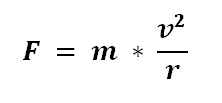As mentioned above centripetal force diminishes to zero as one nears the poles, since the radius gets smaller as you approach the poles. Centripetal force is the resting mass times the circular path’s velocity squared divided by the circular path’s radius.
The centripetal force formula is:

where:
F is force in Newtons,
v is the rotational speed in meters per second
m is mass in kilograms, and
r is radius in meters.
Velocity is the distance around the circular path (circumference) divided by the time in seconds. The velocity formula is:

where:
d is distance or circumference of the planet at that latitude in meters, and
t is time in seconds and fixed at 24 hours * 3,600 seconds per hour.
Velocity changes with latitude. To compute the velocity requires getting the path length or circumference at the particular latitude. The distance at a particular latitude formula is:

where:
d is distance in meters,
π is pi or 3.1416,
r is radius in meters, and
l is latitude.
To get the distance at a latitude, we multiply the distance formula by cosine times the latitude in degrees.
We plug the distance formula in place of d in the velocity formula. We then plug the updated velocity formula into the centripetal force formula giving us the general formula for centripetal (tangential) force at latitude.

We plug the distance formula in place of d in the velocity formula. We then plug the updated velocity formula into the centripetal force formula giving us the general formula for centripetal (tangential) force at latitude.
Figure 2 shows tangential weather force at various latitudes. Maximum horizontal weather (tangential) force is near 35 degrees latitude and is on the order of .0006 Newtons. In today’s media vernacular I could call it 600 micro Newtons and dismiss it out of hand since it doesn’t match current ‘accepted science.’ Please hang with me here and hopefully I’ll convince you that 100,000,000,000 pounds of force is adequate to whip the atmosphere into quite a tizzy, especially when hours and days of application are involved
The atmosphere weights 14.7 PSI * 3.19 X 1014 sq. in. = 4.69 X 1015 pounds. About 30% of the atmosphere is subject to significant tangential weather giving 1.4 X 1016 lbs of tangential weather affected atmosphere. The force per pound is .00014 lbf resulting in 1,890,000,000,000 lbf. That is a lot of force and since the atmosphere moves, it is a lot of energy.
I’ll bet that there is even more seething energy being exhibited by metric system cultists. 🙂
Return to 21st Century Weather Science
